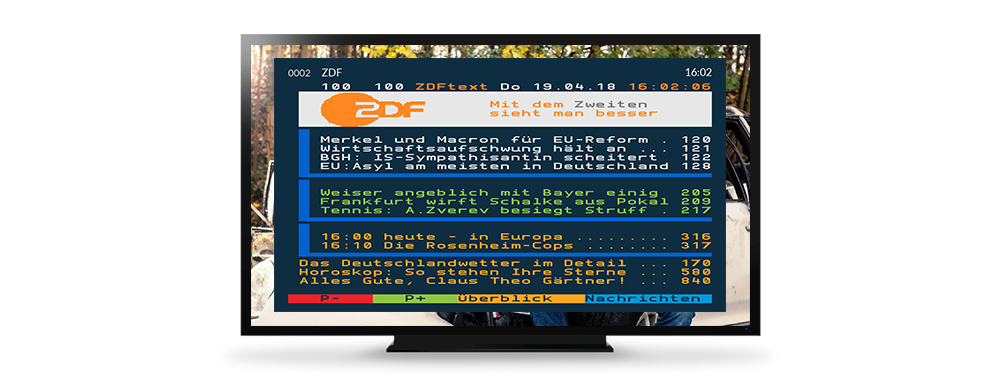


Remember: PAL is a beast of a spectrum hog - not only are PAL channels insanely wide, but also transmission power is ridiculously high for the data it actually transports. Just when you’d only see moving snow with remnants of silhouettes I find DVB-T to totally fail. Now, the decoded transport bitstream is MPEG-2, which itself is rather robust agains bit errors here and there, so you might not even notice your data is wrong. DVB-T is rather robust, it takes hell of an SNR to actually get significant bit error rates - there is lot of forward error correction employed, so for a big range of signal quality, the video quality actually doesn’t suffer.

#ZDF TELETEXT 720P#
Actually, most programs receivable today use 720p around here - I don’t need to explain the difference between that an a PAL moving picture on a digital screen. In fact, PAL was a terrible standard when it comes to video quality by modern standards it actually streamed a 288 px wide video, that, if you’re really tolerant could claim was 576px wide - that’s worse than the first youtube videos, and simply no comparison with a “normal” DVB-T Mpeg2 encoded stream, even if it’s transmitted in SD (which has the full, non-interleaved width). *the image quality went down with compression*Īlmost certainly not. * subtitles tag only sent before transmission, so DVRs might miss it when started too late * promised superteletext never materialized * became more susceptible to interference * the image quality went down with compression Let’s have a look at the claims you make: OK, this is as lot love for an absolute terrible standard as I can take at one. The only thing it actually did was cram more channels in the same radio space, at the expense of making television work like shit. Teletext originally provided a robust way to transmit switchable multi-language subtitles because of that.Īll of the promises of digital television never actually materialized: the image quality went down with compression, the range went down because the broadcast doesn’t degrade gracefully with marginal reception, it became more susceptible to interference like frayed spark plug wires and elevators turning on/off even where reception is good, the promised “superteletext” never materialized, the dedicated subtitle transmission system in DVB skips and drops lines every single time you try to watch a program and DVRs won’t capture the subtitles if you time the recording before the broadcaster puts the “subtitles” flag up in the starting minute of the show – it’s just dysfunctional to the point that broadcasters have started to employ burned-in subtitles again after so many years. Teletext is still being broadcast as yet another stream in DVB, but it’s not really the same anymore because it gets set sparsely as a big blob of data instead of continuously every blanking interval. Posted in Raspberry Pi Tagged pal, protocol, raspberry pi, teletext Post navigation
#ZDF TELETEXT CODE#
There’s also a ‘clock cracker’ with a picture of Tux that should help diagnose reception issues.Īll the code is available on the project’s github, although hasn’t released the scripts to output teletext pages captured from broadcast signals years ago. Right now there are two demos, a Raspi status display that shows the CPU frequency, usage, memory, and temperature. The new build does away with this completely, allowing any Raspberry Pi to generate and display information from a teletext service. This isn’t ’s first teletext rodeo earlier he built an add-on board for the Raspi that uses an AVR and an LM1881 video sync separator to mux the video output of a Raspi with teletext signals.
#ZDF TELETEXT GENERATOR#
Playing with dead protocols is fun, though, and since the Raspberry Pi has an analog video out, thought it would be fun to turn his Pi into a teletext generator and display. For about 30 years, teletext was one of the most reliable means of information distribution until it was quietly shelved with the rollout of digital television.

Way back in the 70s, the UK and BBC rolled out teletext – an information retrieval service that’s much closer to the ‘television screens connected to computers the size of a room’ popularized by 1960s futurists than the Internet and world wide web.


 0 kommentar(er)
0 kommentar(er)
